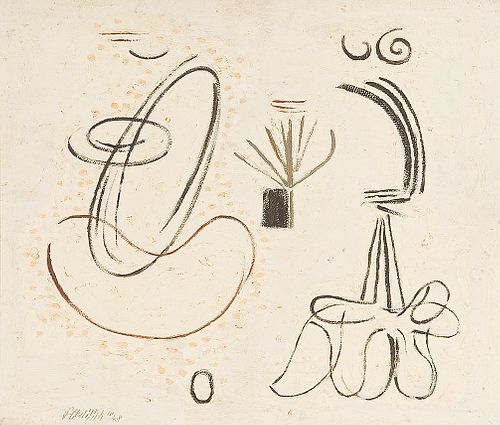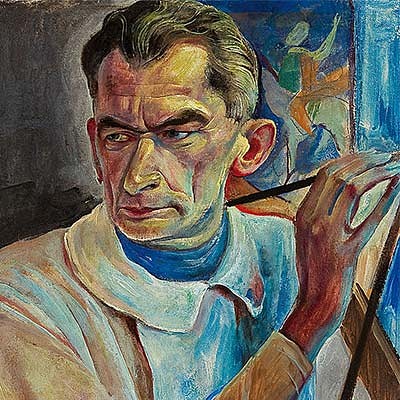WILLI BAUMEISTER* (Stuttgart 1889 - 1955 Stuttgart)
Lot 260
Estimate:
EUR€15,000 - EUR€25,000
$15,625 - $26,041.67
Absentee vs Live bid
Two ways to bid:
- Leave a max absentee bid and the platform will bid on your behalf up to your maximum bid during the live auction.
- Bid live during the auction and your bids will be submitted real-time to the auctioneer.
Bid Increments
| Price | Bid Increment |
|---|---|
| EUR€0 | EUR€10 |
| EUR€100 | EUR€50 |
| EUR€700 | EUR€100 |
| EUR€1,000 | EUR€200 |
| EUR€3,000 | EUR€300 |
| EUR€3,600 | EUR€400 |
| EUR€4,000 | EUR€500 |
| EUR€7,000 | EUR€1,000 |
| EUR€16,000 | EUR€2,000 |
| EUR€30,000 | EUR€3,000 |
| EUR€36,000 | EUR€4,000 |
| EUR€40,000 | EUR€5,000 |
| EUR€150,000 | EUR€10,000 |
About Auction
By Widder Auctions
Nov 28, 2022
Set Reminder
2022-11-28 10:00:00
2022-11-28 10:00:00
America/New_York
Bidsquare
Bidsquare : Viennese Art Nouveau, Expressionism, Modern Art
https://www.bidsquare.com/auctions/widder-auctions/viennese-art-nouveau-expressionism-modern-art-10414
Widder Auctions office@widderauktionen.com
Widder Auctions office@widderauktionen.com
- Lot Description
WILLI BAUMEISTER*
(Stuttgart 1889 - 1955 Stuttgart)
Dialogue, 1948
oil/cardboard, 46 x 54 cm
signed Baumeister, dated 1948, verso inscribed (Dialog) 1948, studio stamp Willi Baumeister
provenance: Inheritance of the artist, gallery Fred Jahn, Munich 2007, Intl. Privatslg., Dep. In WKVZ. Baumeister, Cologne 1963, NO B 1088, p. 429
ESTIMATE #Euro 15.000 - 25.000
STARTING PRICE #Euro 15.000
The German painter, graphic artist, stage designer, typographer, art theorist, author, and university lecturer Willi Baumeister (Friedrich Wilhelm Baumeister) was an important modernist artist. While training as a decorative painter, Baumeister took up art studies at the Stuttgart Art Academy in 1905/1906, attending Robert Poetzelberger's drawing class and taking lessons from Josef Kerschensteiner. Baumeister switched to Adolf Hoelzel's composition class, to which he belonged (with an interruption due to the war) until 1919. Here he met Oskar Schlemmer and Alf Bayrle. He participated in an exhibition in Zurich in 1912 and in the First German Autumn Salon at the Sturm-Galerie in Berlin in 1913. Here he met Franz Marc. In 1914 Baumeister had his first solo exhibition at the Stuttgart "Neuer Kunstsalon. In the same year Adolf Hoelzel commissioned Baumeister, Schlemmer, and Hermann Stenner to execute murals at the Cologne Werkbund exhibition. At the Stuttgart exhibition of the Association of Friends of Art in the Lands on the Rhine in 1914, Baumeister, Josef Eberz, and Schlemmer were prominently represented in the "Expressionist Hall. "In 1915 Baumeister met Oskar Kokoschka and Adolf Loos in Vienna. In 1916 he participated in the exhibition "Hoelzel and His Circle" at the Kunstverein Freiburg im Breisgau, which was also shown in 1917 at the Kunstsalon Ludwig Schames in Frankfurt am Main. In 1918 he exhibited with Oskar Schlemmer at the Schaller Gallery in Stuttgart. Baumeister was probably a member of the Berlin artists' association "Novembergruppe" founded by Max Pechstein. In 1919 Baumeister founded the artist group ueecht with Schlemmer, among others (he left in 1921). In 1919 he produced his first stage design. In 1922 he studied at the Stuttgart Academy under Heinrich Altherr. He worked as a freelance artist and participated in exhibitions in Berlin, Dresden and Hagen. In 1922 he exhibited with Fernand Léger at the Berlin gallery "Der Sturm" and developed relationships with Paul Klee, Léger, Le Corbusier, Ozenfant and Michel Seuphor. In 1924 his works were shown at the "First General German Art Exhibition" in Moscow. In 1925 Baumeister became a special expert for colored house paints for the Wuerttemberg Building Advisory Office and participated in the Paris exhibition L'Art d'aujourd'hui. In addition to his artistic work, he devoted himself in parallel to commercial art and designed advertisements for companies (Bosch and DLW (Deutsche Linoleumwerke). In 1926 Willi Baumeister married the painter Margarete Oehm and participated in the International Exhibition of Modern Art in New York. A solo exhibition in Paris followed in 1927; on the occasion of his participation in the Great Berlin Art Exhibition he met Kasimir Malevich. In 1927 Baumeister became chief graphic designer at DLW and, on the recommendation of Fritz Wichert, was appointed to the Frankfurt Kunstgewerbeschule (Staedelschule), where he headed the class for commercial graphics, typography, and fabric printing. He turned down an appointment to the Bauhaus in Dessau. In 1929 Baumeister took part in the anniversary exhibition in the Cologne Staatenhaus at Rheinpark. From 1930 he was in charge of the design of the magazine of Neues Frankfurt. In 1931 the magazine "Der Querschnitt" appeared with Baumeister's cover design. Baumeister had been a member of the "ring neue werbegestalter" since 1927 (chairman: Kurt Schwitters), joined the artist association Cercle et Carré in 1930, and received the Wuerttemberg State Prize for the painting Linienfigur in 1930. He was also a member of the artist movement Abstraction-Création in Paris. In 1933 Willi Baumeister's professorship at the Kunstgewerbeschule was cut as a result of the seizure of power, and his colleagues Albert Windisch and Wilhelm Biering were forced to take over Baumeister's courses as well. Elisabeth Hase, Marta Hoepffner, Jacques Germain, Hannes Neuner, and Jo von Kalckreuth were among Baumeister's students in Frankfurt. In 1936 he met Kurt Herberts through the Wuppertal architect Heinz Rasch and from 1937 worked with Hans Hildebrandt, Franz Krause, Alfred Loercher, Georg Muche, and Oskar Schlemmer in the latter's Wuppertal working group. In 1937 a number of Baumeister's panel paintings, watercolors, prints, and drawings were confiscated in the Nazi "Degenerate Art" campaign. Five of the works were shown in the "Degenerate Art" exhibition. From 1944 Baumeister had a close friendship with Alfred Eichhorn. In 1949 Baumeister was a co-founder of the artists' group "Gegenstandslose," which exhibited for the first time in 1950 under the name "ZEN 49". Baumeister met Fritz Winter and Ernst Wilhelm Nay. In July 1950 he took part in the "First Darmstadt Talk" on the occasion of the exhibition "The Image of Man in Our Time". Baumeister defended modern art against Hans Sedlmayr's thesis of the "loss of the center". Among Baumeister's students were Klaus Bendixen, Karl Bohrmann, Peter Bruening, Hans Werner Geerdts, Peter Grau, Klaus Juergen-Fischer, Herbert W. Kapitzki, Emil Kiess, Frans Krajcberg, Antonio Máro, Eduard Micus, Luisa Richter, Friedrich Seitz, Gerhard Uhlig, and Ludwig Wilding.
PLEASE NOTE:
The purchase price consists of the highest bid plus the buyer's premium, sales tax and, if applicable, the fee of artists resale rights. In the case of normal taxation (marked #), a premium of 24% is added to the highest bid. The mandatory sales tax of 13%, for photographys 20%, is added to the sum of the highest bid and the buyer's premium. The buyer's premium amounts to 28% in case of differential taxation. The sales tax is included in the differential taxation. - Shipping Info
-
We will send you the invoice shortly after the auction. As soon as we have recieved the amount, the art can be picked up at Johannesgasse 9-13, 1010 Vienna. Please note that the buyer is responsible for pick-up and shipping of the lot. Should you wish to ship your items, please contact: Mailboxes Email: oper@mbe-co.at Tel: 01 5128855 Please note that storage fees may apply, should the pieces not be picked up within 14 days after invoicing for domestic and 28 days for international transportation. Our team will be happy to assist you with any further information at office@widderauktionen.com or at 0043 676 555 66 10.
-
- Buyer's Premium



 EUR
EUR CAD
CAD AUD
AUD GBP
GBP MXN
MXN HKD
HKD CNY
CNY MYR
MYR SEK
SEK SGD
SGD CHF
CHF THB
THB













